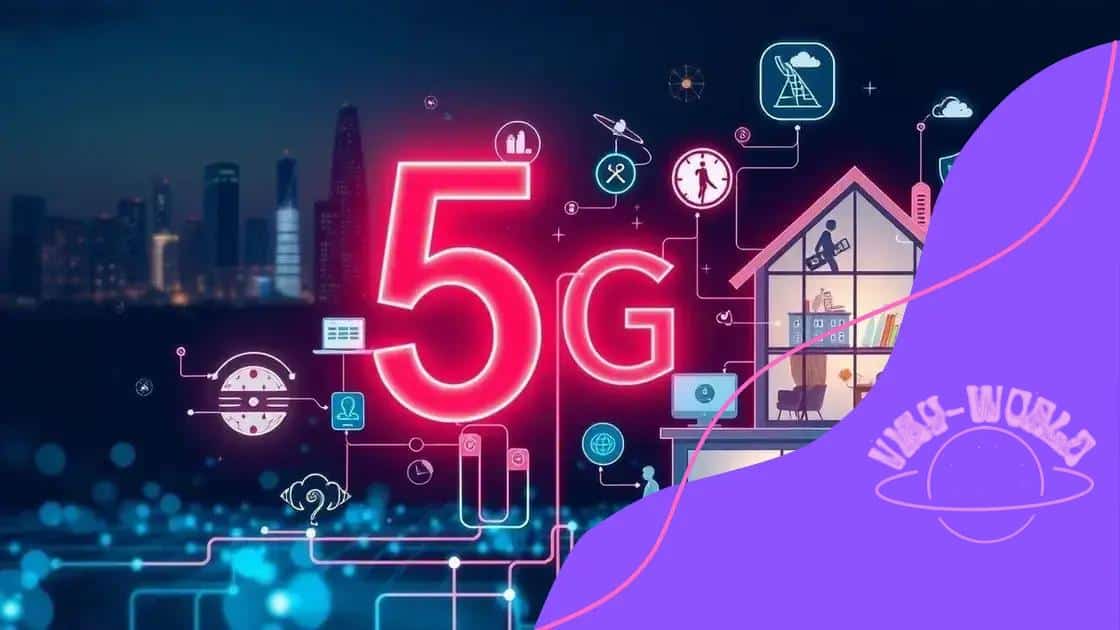5G accelerating IoT device adoption for a smarter future

5G is revolutionizing IoT device adoption by providing faster speeds, lower latency, and the ability to connect a larger number of devices, enhancing connectivity and enabling real-time data processing across various applications.
5G accelerating IoT device adoption is changing the landscape of technology as we know it. Have you considered how this shift impacts your daily life? Let’s dive into the exciting implications of this phenomenon.
How 5G enhances connectivity for IoT devices
5G is revolutionizing how we connect our devices. With its incredible speed and low latency, it enhances the ability of IoT devices to communicate effectively. This means that devices will operate more smoothly and respond faster to user commands.
How does 5G enhance connectivity for IoT devices? One major reason is its ability to support a larger number of devices simultaneously. This is crucial as we see a significant increase in the number of IoT devices in homes and businesses.
Improved Speed
The speeds provided by 5G networks can be up to 100 times faster than 4G, leading to superior performance for connected devices. This results in quicker data transfer and almost instant communication between devices.
Low Latency
Another benefit is the low latency that 5G offers. With delays reduced to milliseconds, IoT devices can perform in real-time. This is essential for applications like smart cars and remote surgeries, where every second counts.
Broader Coverage
5G also provides broader coverage, making it easier for IoT devices to connect in various environments. For instance, remote areas that previously had poor connectivity can now support not only single devices but entire networks of smart devices.
- Increased speed enables better data handling.
- Low latency ensures immediate responses from devices.
- Greater capacity allows more devices to connect simultaneously.
- Wider coverage facilitates IoT deployment in diverse locations.
Moreover, the energy efficiency of 5G is a significant advantage. IoT devices usually run on battery power and can leverage 5G technology to preserve energy while remaining connected. This means longer-lasting devices that require less frequent recharging.
As industries explore the benefits of 5G, the potential applications continue to expand. Smart homes, smart cities, and industrial automation are just a few areas where 5G enhances connectivity for IoT devices. This transformation could redefine our daily habits and workflows, ushering in a new era of technology that connects all elements seamlessly.
Key benefits of 5G for IoT adoption
5G technology brings numerous advantages that significantly impact IoT adoption. These benefits create a more connected world, enhancing our daily lives and the efficiency of businesses.
One of the most notable advantages is the improved speed that 5G offers. It allows for much faster data transfer rates compared to previous generations. This means that IoT devices can send and receive information in real-time, which is crucial for applications like remote monitoring and smart city management.
Enhancing Device Connectivity
5G networks can support a higher density of connected devices, making it easier for businesses and homes to adopt multiple IoT devices. This increased capacity helps streamline operations, whether in a factory or a smart home.
Energy Efficiency
Another critical benefit of 5G is its energy efficiency. IoT devices generally consume less battery power when using 5G technology. This is important for devices that are often powered by batteries, as it helps reduce maintenance costs and improves device longevity.
- Increased bandwidth allows for more devices to connect simultaneously.
- Lower energy consumption extends battery life for IoT devices.
- Faster response times enhance the user experience, especially in critical applications.
- Better coverage ensures connectivity even in remote or challenging environments.
Moreover, the low latency of 5G can transform how we use IoT devices in sensitive applications. For example, in healthcare, quicker response times can lead to better patient care through telemedicine or remote surgeries, where every second counts.
In addition to these technical benefits, 5G promotes innovation across various sectors. Businesses can leverage the capabilities of IoT devices to develop solutions that solve complex problems, thus driving efficiency and productivity. As more industries adopt 5G technology, we can expect a significant improvement in operational effectiveness and new opportunities.
Real-world applications of 5G in IoT

The real-world applications of 5G in IoT are rapidly expanding. The unique capabilities of 5G technology provide innovative solutions that significantly enhance various industries.
One key application is in smart cities. Here, 5G enables seamless communication between devices like traffic lights, cameras, and public transport systems. This interconnectedness helps manage resources effectively, reduces traffic congestion, and enhances public safety.
Healthcare Innovations
Another area transformed by 5G is healthcare. Remote monitoring devices can transmit patient data in real-time, allowing doctors to respond quickly to emergencies. IoT devices equipped with 5G technology can facilitate telemedicine, allowing patients to receive care without visiting a hospital.
Smart Homes and Appliances
5G is also driving advancements in smart homes. Home devices can connect more efficiently, providing users with better control over appliances, security systems, and energy consumption. This leads to increased convenience and reduced energy costs.
- Smart thermostats adjust heating or cooling based on usage patterns.
- Security cameras can stream high-definition video in real-time.
- Smart refrigerators can monitor contents and suggest recipes.
- IoT health wearables track fitness levels and health data.
In manufacturing, 5G supports automation and robotics. Factories can employ IoT sensors to monitor equipment conditions, enhancing predictive maintenance. This reduces downtime and improves overall efficiency. Moreover, augmented reality (AR) applications are emerging, allowing workers to access real-time data while performing tasks.
Overall, the integration of 5G in IoT applications is transforming various sectors, from transportation and healthcare to smart homes. As these technologies become commonplace, we can expect enhanced quality of life and increased operational efficiency across the board.
Challenges in 5G implementation for IoT
Despite the advantages, the implementation of 5G for IoT faces several challenges. Understanding these issues is crucial for companies looking to adopt this technology effectively.
One major challenge is the network infrastructure. Building a robust 5G network requires significant investment in new equipment and technology. This involves upgrading existing cellular towers and laying down new fiber optic cables to support faster data transmission.
Regulatory and Compliance Issues
Another significant hurdle involves regulatory and compliance concerns. Different countries have various regulations governing the deployment of new telecommunications technologies. Navigating these regulations can be complex and time-consuming, delaying implementation.
Security Concerns
Security is also a critical issue. As IoT devices become more interconnected, the risk of cyberattacks increases. Companies must ensure robust security measures are in place. This includes protecting data and maintaining the privacy of users, which is essential for building trust.
- The increase in connected devices raises potential vulnerabilities.
- Constant updates and monitoring are needed for devices.
- Data privacy must be prioritized to protect user information.
- Collaboration among stakeholders can enhance security measures.
Another challenge is the need for skilled personnel. As 5G technology is relatively new, there is a shortage of trained professionals who can implement and manage these systems effectively. Organizations may need to invest in training their staff or hire new experts to facilitate this transition.
Lastly, there is the issue of consumer adoption. Many users may be hesitant to switch to 5G due to a lack of understanding or concern about costs. Effective communication about the benefits of 5G, such as faster speeds and better reliability, is necessary to encourage broader adoption.
Future trends: What’s next for 5G and IoT?
The future of 5G and IoT is bright, with numerous exciting trends on the horizon. As technology evolves, businesses and consumers alike will benefit from advancements that enhance connectivity and functionality.
One significant trend is the growth of edge computing. As IoT devices continue to increase, processing data closer to where it’s generated will be essential. This reduces latency and improves responsiveness, allowing for real-time decision-making in applications like autonomous vehicles and smart cities.
Integration with AI
Another upcoming trend is the integration of artificial intelligence (AI) with 5G technology. AI can help analyze the vast amount of data generated by IoT devices, leading to improved efficiency and smarter applications. For instance, businesses can use AI to predict equipment failures before they happen, saving time and resources.
Expansion of Smart Cities
The expansion of smart cities is also a key trend. As cities adopt 5G networks, more devices will connect to optimize daily operations. This includes everything from smart traffic management systems to enhanced public safety measures through connected surveillance.
- Smart transportation systems will reduce congestion and improve travel time.
- Connected waste management will streamline garbage collection operations.
- Public health systems will use IoT to monitor environmental conditions.
- Energy-efficient systems will monitor consumption and reduce overhead costs.
Moreover, the demand for more secure and resilient networks will grow. With the rise of connected devices, cybersecurity will become increasingly vital. Companies will need to implement advanced security measures to protect user data and maintain trust.
Finally, as global 5G adoption increases, new business models will emerge. From new services to enhanced experiences, companies will find innovative ways to leverage 5G and IoT capabilities. This shift will likely open up market opportunities in various sectors, creating a ripple effect of economic growth and technological advancement.
FAQ – Frequently Asked Questions about 5G and IoT
What is 5G technology?
5G technology is the fifth generation of mobile networks, offering faster speeds, lower latency, and the ability to connect more devices than previous generations.
How does 5G enhance IoT devices?
5G enhances IoT devices by providing higher bandwidth and faster data transfer, allowing devices to communicate in real-time for better functionality.
What are the challenges of implementing 5G?
Challenges include the need for significant infrastructure investment, navigating regulatory requirements, ensuring cybersecurity, and addressing skills shortages in the workforce.
What future trends can we expect in 5G and IoT?
Future trends include the rise of edge computing, AI integration, expanded smart city applications, and increased focus on security and data privacy.


